Analysis of Literature on the HR Business Partner Model
VerifiedAdded on 2023/06/07
|9
|2484
|331
AI Summary
This article analyzes the HR Business Partner Model, its benefits, challenges, and evolution. It discusses the role of HRM in modern organizations and how the model helps in managing employees effectively. The article also highlights the changes that the HRM department has undergone over the years.
Contribute Materials
Your contribution can guide someone’s learning journey. Share your
documents today.
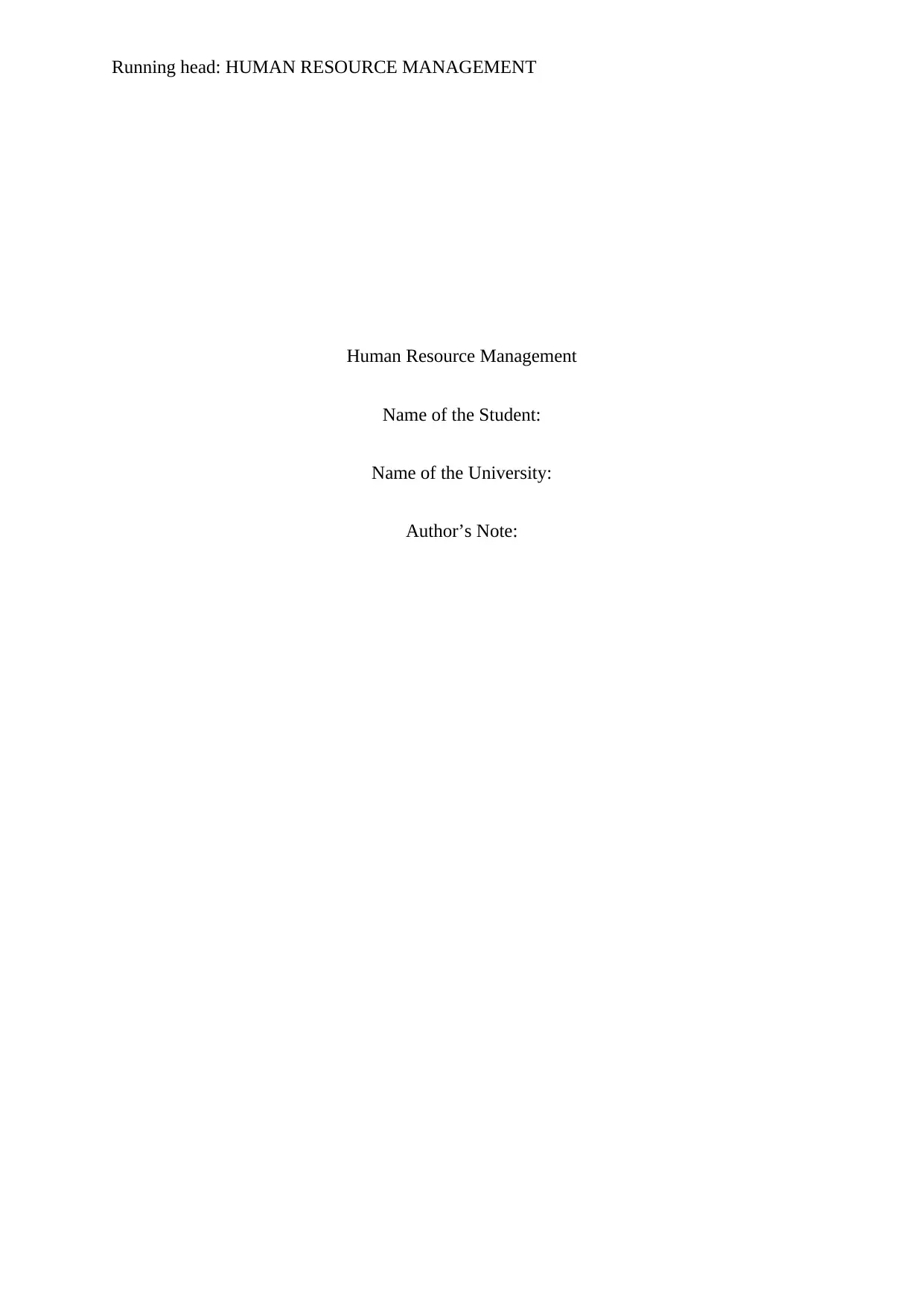
Running head: HUMAN RESOURCE MANAGEMENT
Human Resource Management
Name of the Student:
Name of the University:
Author’s Note:
Human Resource Management
Name of the Student:
Name of the University:
Author’s Note:
Secure Best Marks with AI Grader
Need help grading? Try our AI Grader for instant feedback on your assignments.
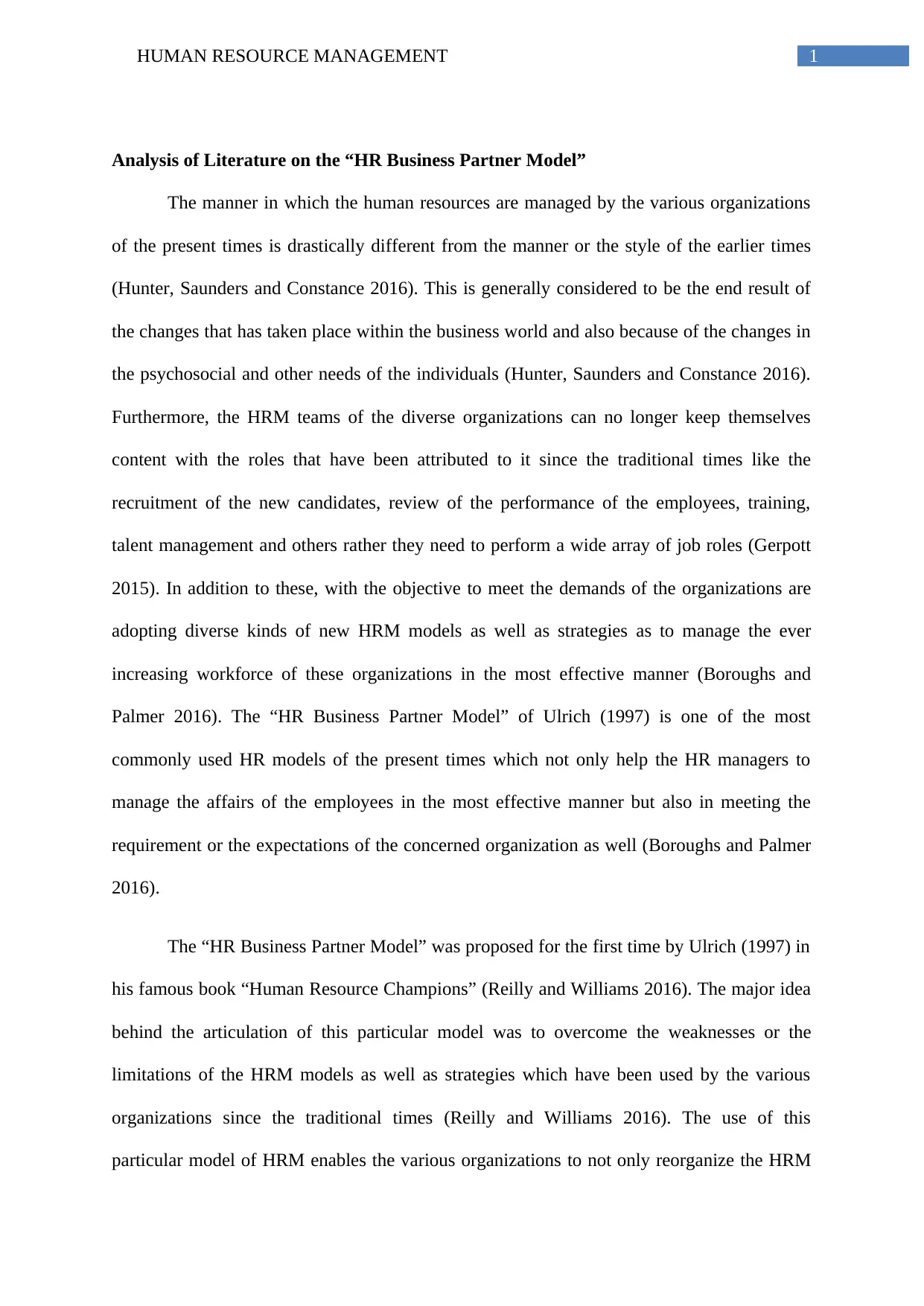
1HUMAN RESOURCE MANAGEMENT
Analysis of Literature on the “HR Business Partner Model”
The manner in which the human resources are managed by the various organizations
of the present times is drastically different from the manner or the style of the earlier times
(Hunter, Saunders and Constance 2016). This is generally considered to be the end result of
the changes that has taken place within the business world and also because of the changes in
the psychosocial and other needs of the individuals (Hunter, Saunders and Constance 2016).
Furthermore, the HRM teams of the diverse organizations can no longer keep themselves
content with the roles that have been attributed to it since the traditional times like the
recruitment of the new candidates, review of the performance of the employees, training,
talent management and others rather they need to perform a wide array of job roles (Gerpott
2015). In addition to these, with the objective to meet the demands of the organizations are
adopting diverse kinds of new HRM models as well as strategies as to manage the ever
increasing workforce of these organizations in the most effective manner (Boroughs and
Palmer 2016). The “HR Business Partner Model” of Ulrich (1997) is one of the most
commonly used HR models of the present times which not only help the HR managers to
manage the affairs of the employees in the most effective manner but also in meeting the
requirement or the expectations of the concerned organization as well (Boroughs and Palmer
2016).
The “HR Business Partner Model” was proposed for the first time by Ulrich (1997) in
his famous book “Human Resource Champions” (Reilly and Williams 2016). The major idea
behind the articulation of this particular model was to overcome the weaknesses or the
limitations of the HRM models as well as strategies which have been used by the various
organizations since the traditional times (Reilly and Williams 2016). The use of this
particular model of HRM enables the various organizations to not only reorganize the HRM
Analysis of Literature on the “HR Business Partner Model”
The manner in which the human resources are managed by the various organizations
of the present times is drastically different from the manner or the style of the earlier times
(Hunter, Saunders and Constance 2016). This is generally considered to be the end result of
the changes that has taken place within the business world and also because of the changes in
the psychosocial and other needs of the individuals (Hunter, Saunders and Constance 2016).
Furthermore, the HRM teams of the diverse organizations can no longer keep themselves
content with the roles that have been attributed to it since the traditional times like the
recruitment of the new candidates, review of the performance of the employees, training,
talent management and others rather they need to perform a wide array of job roles (Gerpott
2015). In addition to these, with the objective to meet the demands of the organizations are
adopting diverse kinds of new HRM models as well as strategies as to manage the ever
increasing workforce of these organizations in the most effective manner (Boroughs and
Palmer 2016). The “HR Business Partner Model” of Ulrich (1997) is one of the most
commonly used HR models of the present times which not only help the HR managers to
manage the affairs of the employees in the most effective manner but also in meeting the
requirement or the expectations of the concerned organization as well (Boroughs and Palmer
2016).
The “HR Business Partner Model” was proposed for the first time by Ulrich (1997) in
his famous book “Human Resource Champions” (Reilly and Williams 2016). The major idea
behind the articulation of this particular model was to overcome the weaknesses or the
limitations of the HRM models as well as strategies which have been used by the various
organizations since the traditional times (Reilly and Williams 2016). The use of this
particular model of HRM enables the various organizations to not only reorganize the HRM
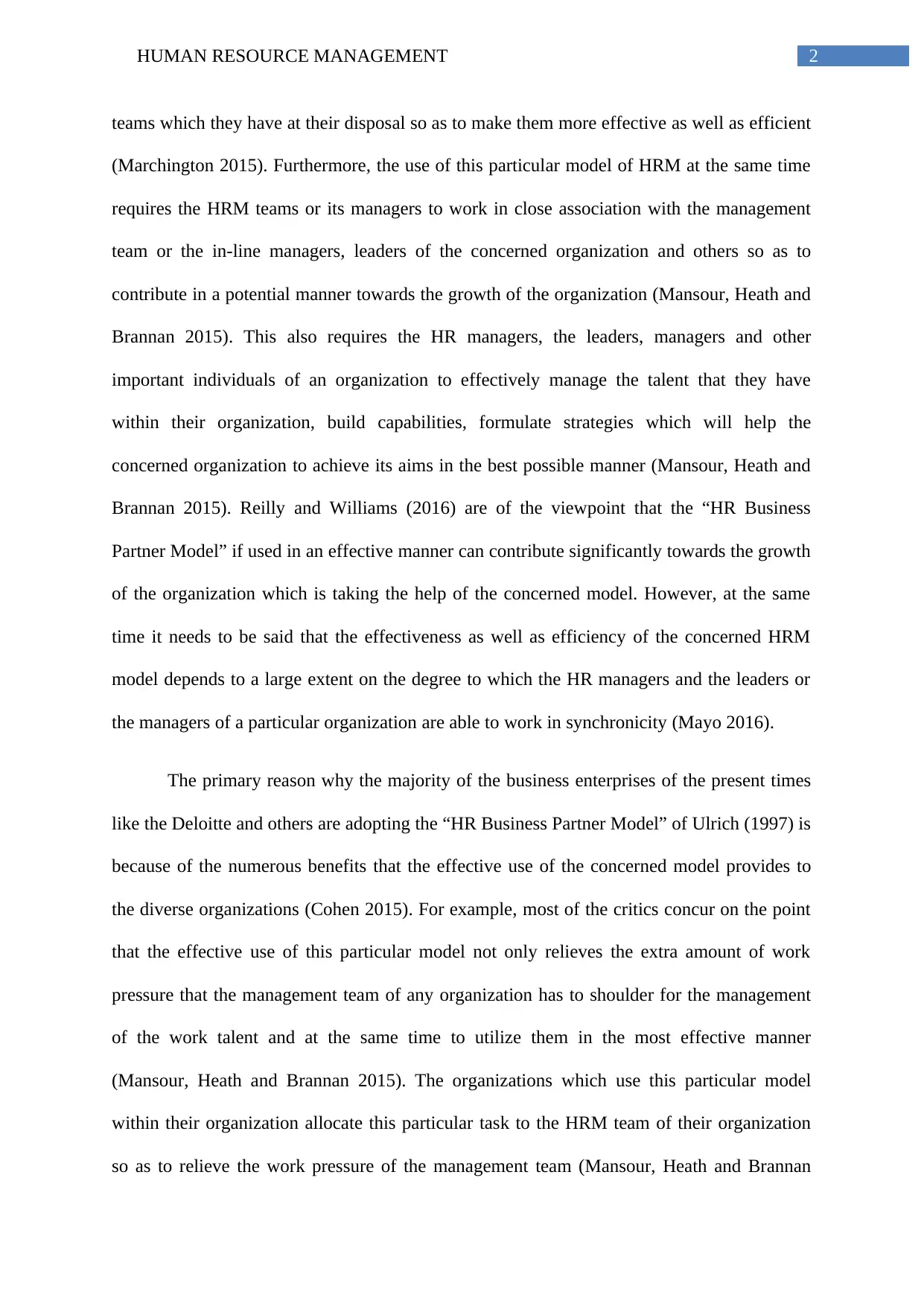
2HUMAN RESOURCE MANAGEMENT
teams which they have at their disposal so as to make them more effective as well as efficient
(Marchington 2015). Furthermore, the use of this particular model of HRM at the same time
requires the HRM teams or its managers to work in close association with the management
team or the in-line managers, leaders of the concerned organization and others so as to
contribute in a potential manner towards the growth of the organization (Mansour, Heath and
Brannan 2015). This also requires the HR managers, the leaders, managers and other
important individuals of an organization to effectively manage the talent that they have
within their organization, build capabilities, formulate strategies which will help the
concerned organization to achieve its aims in the best possible manner (Mansour, Heath and
Brannan 2015). Reilly and Williams (2016) are of the viewpoint that the “HR Business
Partner Model” if used in an effective manner can contribute significantly towards the growth
of the organization which is taking the help of the concerned model. However, at the same
time it needs to be said that the effectiveness as well as efficiency of the concerned HRM
model depends to a large extent on the degree to which the HR managers and the leaders or
the managers of a particular organization are able to work in synchronicity (Mayo 2016).
The primary reason why the majority of the business enterprises of the present times
like the Deloitte and others are adopting the “HR Business Partner Model” of Ulrich (1997) is
because of the numerous benefits that the effective use of the concerned model provides to
the diverse organizations (Cohen 2015). For example, most of the critics concur on the point
that the effective use of this particular model not only relieves the extra amount of work
pressure that the management team of any organization has to shoulder for the management
of the work talent and at the same time to utilize them in the most effective manner
(Mansour, Heath and Brannan 2015). The organizations which use this particular model
within their organization allocate this particular task to the HRM team of their organization
so as to relieve the work pressure of the management team (Mansour, Heath and Brannan
teams which they have at their disposal so as to make them more effective as well as efficient
(Marchington 2015). Furthermore, the use of this particular model of HRM at the same time
requires the HRM teams or its managers to work in close association with the management
team or the in-line managers, leaders of the concerned organization and others so as to
contribute in a potential manner towards the growth of the organization (Mansour, Heath and
Brannan 2015). This also requires the HR managers, the leaders, managers and other
important individuals of an organization to effectively manage the talent that they have
within their organization, build capabilities, formulate strategies which will help the
concerned organization to achieve its aims in the best possible manner (Mansour, Heath and
Brannan 2015). Reilly and Williams (2016) are of the viewpoint that the “HR Business
Partner Model” if used in an effective manner can contribute significantly towards the growth
of the organization which is taking the help of the concerned model. However, at the same
time it needs to be said that the effectiveness as well as efficiency of the concerned HRM
model depends to a large extent on the degree to which the HR managers and the leaders or
the managers of a particular organization are able to work in synchronicity (Mayo 2016).
The primary reason why the majority of the business enterprises of the present times
like the Deloitte and others are adopting the “HR Business Partner Model” of Ulrich (1997) is
because of the numerous benefits that the effective use of the concerned model provides to
the diverse organizations (Cohen 2015). For example, most of the critics concur on the point
that the effective use of this particular model not only relieves the extra amount of work
pressure that the management team of any organization has to shoulder for the management
of the work talent and at the same time to utilize them in the most effective manner
(Mansour, Heath and Brannan 2015). The organizations which use this particular model
within their organization allocate this particular task to the HRM team of their organization
so as to relieve the work pressure of the management team (Mansour, Heath and Brannan
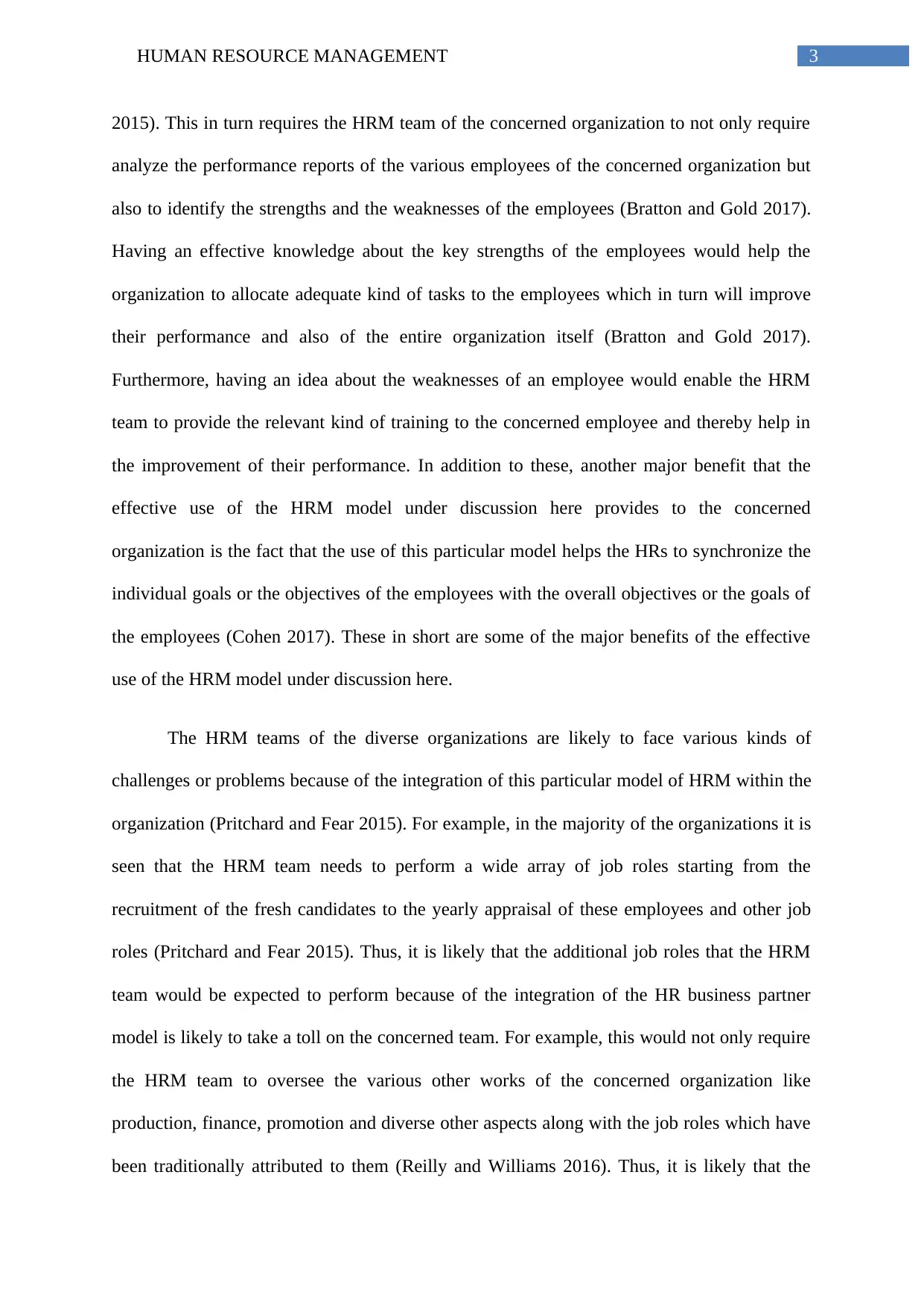
3HUMAN RESOURCE MANAGEMENT
2015). This in turn requires the HRM team of the concerned organization to not only require
analyze the performance reports of the various employees of the concerned organization but
also to identify the strengths and the weaknesses of the employees (Bratton and Gold 2017).
Having an effective knowledge about the key strengths of the employees would help the
organization to allocate adequate kind of tasks to the employees which in turn will improve
their performance and also of the entire organization itself (Bratton and Gold 2017).
Furthermore, having an idea about the weaknesses of an employee would enable the HRM
team to provide the relevant kind of training to the concerned employee and thereby help in
the improvement of their performance. In addition to these, another major benefit that the
effective use of the HRM model under discussion here provides to the concerned
organization is the fact that the use of this particular model helps the HRs to synchronize the
individual goals or the objectives of the employees with the overall objectives or the goals of
the employees (Cohen 2017). These in short are some of the major benefits of the effective
use of the HRM model under discussion here.
The HRM teams of the diverse organizations are likely to face various kinds of
challenges or problems because of the integration of this particular model of HRM within the
organization (Pritchard and Fear 2015). For example, in the majority of the organizations it is
seen that the HRM team needs to perform a wide array of job roles starting from the
recruitment of the fresh candidates to the yearly appraisal of these employees and other job
roles (Pritchard and Fear 2015). Thus, it is likely that the additional job roles that the HRM
team would be expected to perform because of the integration of the HR business partner
model is likely to take a toll on the concerned team. For example, this would not only require
the HRM team to oversee the various other works of the concerned organization like
production, finance, promotion and diverse other aspects along with the job roles which have
been traditionally attributed to them (Reilly and Williams 2016). Thus, it is likely that the
2015). This in turn requires the HRM team of the concerned organization to not only require
analyze the performance reports of the various employees of the concerned organization but
also to identify the strengths and the weaknesses of the employees (Bratton and Gold 2017).
Having an effective knowledge about the key strengths of the employees would help the
organization to allocate adequate kind of tasks to the employees which in turn will improve
their performance and also of the entire organization itself (Bratton and Gold 2017).
Furthermore, having an idea about the weaknesses of an employee would enable the HRM
team to provide the relevant kind of training to the concerned employee and thereby help in
the improvement of their performance. In addition to these, another major benefit that the
effective use of the HRM model under discussion here provides to the concerned
organization is the fact that the use of this particular model helps the HRs to synchronize the
individual goals or the objectives of the employees with the overall objectives or the goals of
the employees (Cohen 2017). These in short are some of the major benefits of the effective
use of the HRM model under discussion here.
The HRM teams of the diverse organizations are likely to face various kinds of
challenges or problems because of the integration of this particular model of HRM within the
organization (Pritchard and Fear 2015). For example, in the majority of the organizations it is
seen that the HRM team needs to perform a wide array of job roles starting from the
recruitment of the fresh candidates to the yearly appraisal of these employees and other job
roles (Pritchard and Fear 2015). Thus, it is likely that the additional job roles that the HRM
team would be expected to perform because of the integration of the HR business partner
model is likely to take a toll on the concerned team. For example, this would not only require
the HRM team to oversee the various other works of the concerned organization like
production, finance, promotion and diverse other aspects along with the job roles which have
been traditionally attributed to them (Reilly and Williams 2016). Thus, it is likely that the
Secure Best Marks with AI Grader
Need help grading? Try our AI Grader for instant feedback on your assignments.
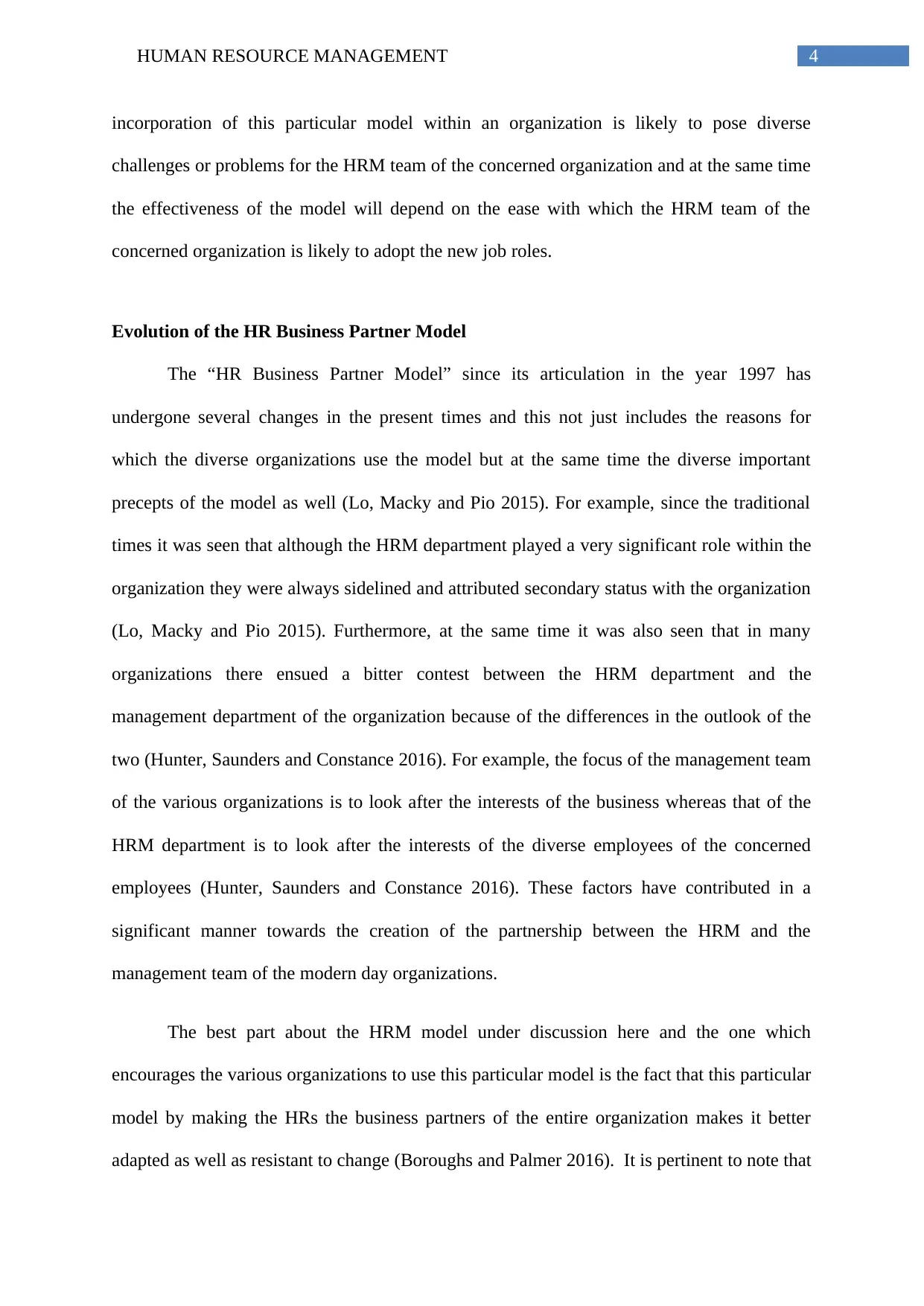
4HUMAN RESOURCE MANAGEMENT
incorporation of this particular model within an organization is likely to pose diverse
challenges or problems for the HRM team of the concerned organization and at the same time
the effectiveness of the model will depend on the ease with which the HRM team of the
concerned organization is likely to adopt the new job roles.
Evolution of the HR Business Partner Model
The “HR Business Partner Model” since its articulation in the year 1997 has
undergone several changes in the present times and this not just includes the reasons for
which the diverse organizations use the model but at the same time the diverse important
precepts of the model as well (Lo, Macky and Pio 2015). For example, since the traditional
times it was seen that although the HRM department played a very significant role within the
organization they were always sidelined and attributed secondary status with the organization
(Lo, Macky and Pio 2015). Furthermore, at the same time it was also seen that in many
organizations there ensued a bitter contest between the HRM department and the
management department of the organization because of the differences in the outlook of the
two (Hunter, Saunders and Constance 2016). For example, the focus of the management team
of the various organizations is to look after the interests of the business whereas that of the
HRM department is to look after the interests of the diverse employees of the concerned
employees (Hunter, Saunders and Constance 2016). These factors have contributed in a
significant manner towards the creation of the partnership between the HRM and the
management team of the modern day organizations.
The best part about the HRM model under discussion here and the one which
encourages the various organizations to use this particular model is the fact that this particular
model by making the HRs the business partners of the entire organization makes it better
adapted as well as resistant to change (Boroughs and Palmer 2016). It is pertinent to note that
incorporation of this particular model within an organization is likely to pose diverse
challenges or problems for the HRM team of the concerned organization and at the same time
the effectiveness of the model will depend on the ease with which the HRM team of the
concerned organization is likely to adopt the new job roles.
Evolution of the HR Business Partner Model
The “HR Business Partner Model” since its articulation in the year 1997 has
undergone several changes in the present times and this not just includes the reasons for
which the diverse organizations use the model but at the same time the diverse important
precepts of the model as well (Lo, Macky and Pio 2015). For example, since the traditional
times it was seen that although the HRM department played a very significant role within the
organization they were always sidelined and attributed secondary status with the organization
(Lo, Macky and Pio 2015). Furthermore, at the same time it was also seen that in many
organizations there ensued a bitter contest between the HRM department and the
management department of the organization because of the differences in the outlook of the
two (Hunter, Saunders and Constance 2016). For example, the focus of the management team
of the various organizations is to look after the interests of the business whereas that of the
HRM department is to look after the interests of the diverse employees of the concerned
employees (Hunter, Saunders and Constance 2016). These factors have contributed in a
significant manner towards the creation of the partnership between the HRM and the
management team of the modern day organizations.
The best part about the HRM model under discussion here and the one which
encourages the various organizations to use this particular model is the fact that this particular
model by making the HRs the business partners of the entire organization makes it better
adapted as well as resistant to change (Boroughs and Palmer 2016). It is pertinent to note that
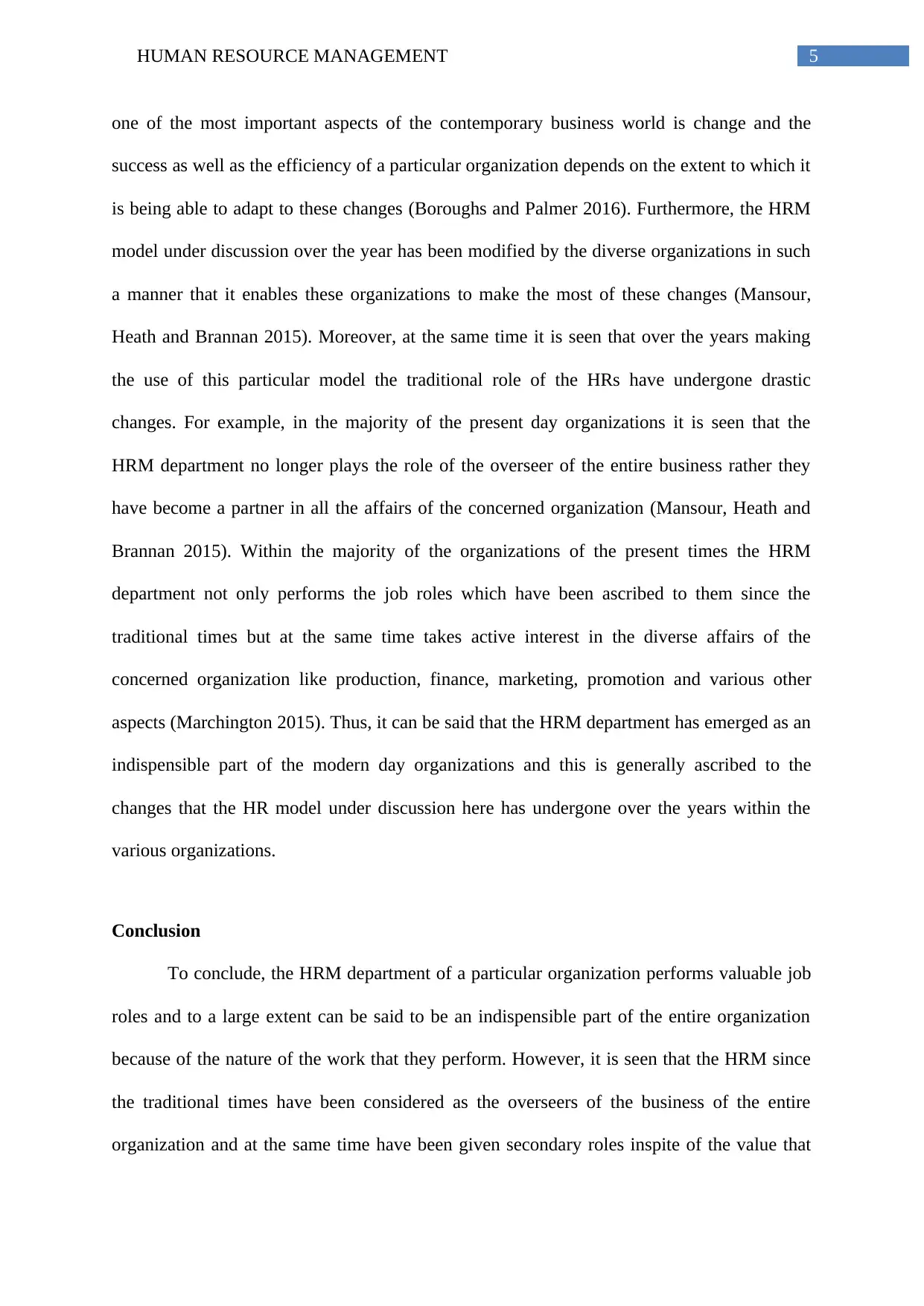
5HUMAN RESOURCE MANAGEMENT
one of the most important aspects of the contemporary business world is change and the
success as well as the efficiency of a particular organization depends on the extent to which it
is being able to adapt to these changes (Boroughs and Palmer 2016). Furthermore, the HRM
model under discussion over the year has been modified by the diverse organizations in such
a manner that it enables these organizations to make the most of these changes (Mansour,
Heath and Brannan 2015). Moreover, at the same time it is seen that over the years making
the use of this particular model the traditional role of the HRs have undergone drastic
changes. For example, in the majority of the present day organizations it is seen that the
HRM department no longer plays the role of the overseer of the entire business rather they
have become a partner in all the affairs of the concerned organization (Mansour, Heath and
Brannan 2015). Within the majority of the organizations of the present times the HRM
department not only performs the job roles which have been ascribed to them since the
traditional times but at the same time takes active interest in the diverse affairs of the
concerned organization like production, finance, marketing, promotion and various other
aspects (Marchington 2015). Thus, it can be said that the HRM department has emerged as an
indispensible part of the modern day organizations and this is generally ascribed to the
changes that the HR model under discussion here has undergone over the years within the
various organizations.
Conclusion
To conclude, the HRM department of a particular organization performs valuable job
roles and to a large extent can be said to be an indispensible part of the entire organization
because of the nature of the work that they perform. However, it is seen that the HRM since
the traditional times have been considered as the overseers of the business of the entire
organization and at the same time have been given secondary roles inspite of the value that
one of the most important aspects of the contemporary business world is change and the
success as well as the efficiency of a particular organization depends on the extent to which it
is being able to adapt to these changes (Boroughs and Palmer 2016). Furthermore, the HRM
model under discussion over the year has been modified by the diverse organizations in such
a manner that it enables these organizations to make the most of these changes (Mansour,
Heath and Brannan 2015). Moreover, at the same time it is seen that over the years making
the use of this particular model the traditional role of the HRs have undergone drastic
changes. For example, in the majority of the present day organizations it is seen that the
HRM department no longer plays the role of the overseer of the entire business rather they
have become a partner in all the affairs of the concerned organization (Mansour, Heath and
Brannan 2015). Within the majority of the organizations of the present times the HRM
department not only performs the job roles which have been ascribed to them since the
traditional times but at the same time takes active interest in the diverse affairs of the
concerned organization like production, finance, marketing, promotion and various other
aspects (Marchington 2015). Thus, it can be said that the HRM department has emerged as an
indispensible part of the modern day organizations and this is generally ascribed to the
changes that the HR model under discussion here has undergone over the years within the
various organizations.
Conclusion
To conclude, the HRM department of a particular organization performs valuable job
roles and to a large extent can be said to be an indispensible part of the entire organization
because of the nature of the work that they perform. However, it is seen that the HRM since
the traditional times have been considered as the overseers of the business of the entire
organization and at the same time have been given secondary roles inspite of the value that
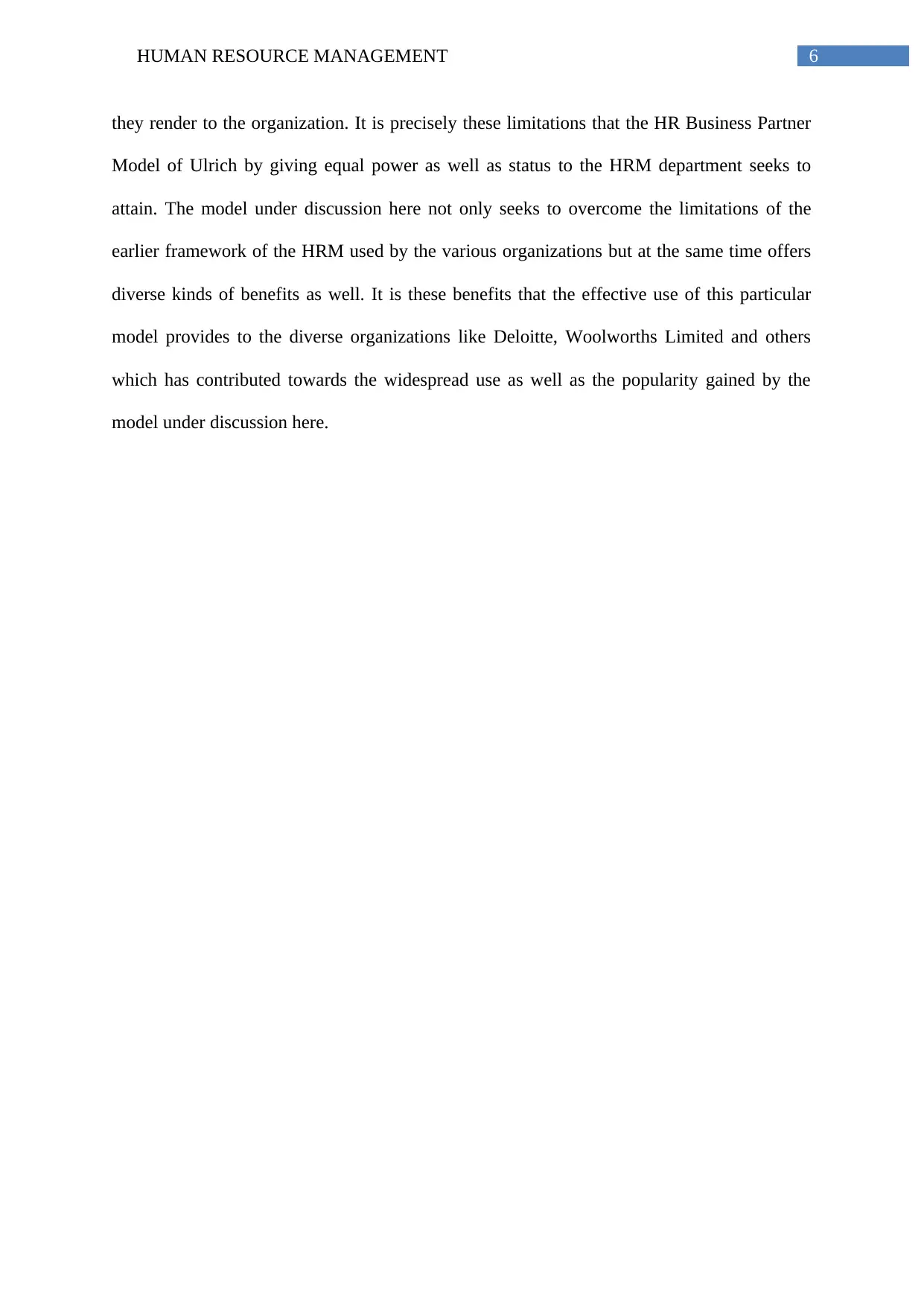
6HUMAN RESOURCE MANAGEMENT
they render to the organization. It is precisely these limitations that the HR Business Partner
Model of Ulrich by giving equal power as well as status to the HRM department seeks to
attain. The model under discussion here not only seeks to overcome the limitations of the
earlier framework of the HRM used by the various organizations but at the same time offers
diverse kinds of benefits as well. It is these benefits that the effective use of this particular
model provides to the diverse organizations like Deloitte, Woolworths Limited and others
which has contributed towards the widespread use as well as the popularity gained by the
model under discussion here.
they render to the organization. It is precisely these limitations that the HR Business Partner
Model of Ulrich by giving equal power as well as status to the HRM department seeks to
attain. The model under discussion here not only seeks to overcome the limitations of the
earlier framework of the HRM used by the various organizations but at the same time offers
diverse kinds of benefits as well. It is these benefits that the effective use of this particular
model provides to the diverse organizations like Deloitte, Woolworths Limited and others
which has contributed towards the widespread use as well as the popularity gained by the
model under discussion here.
Paraphrase This Document
Need a fresh take? Get an instant paraphrase of this document with our AI Paraphraser
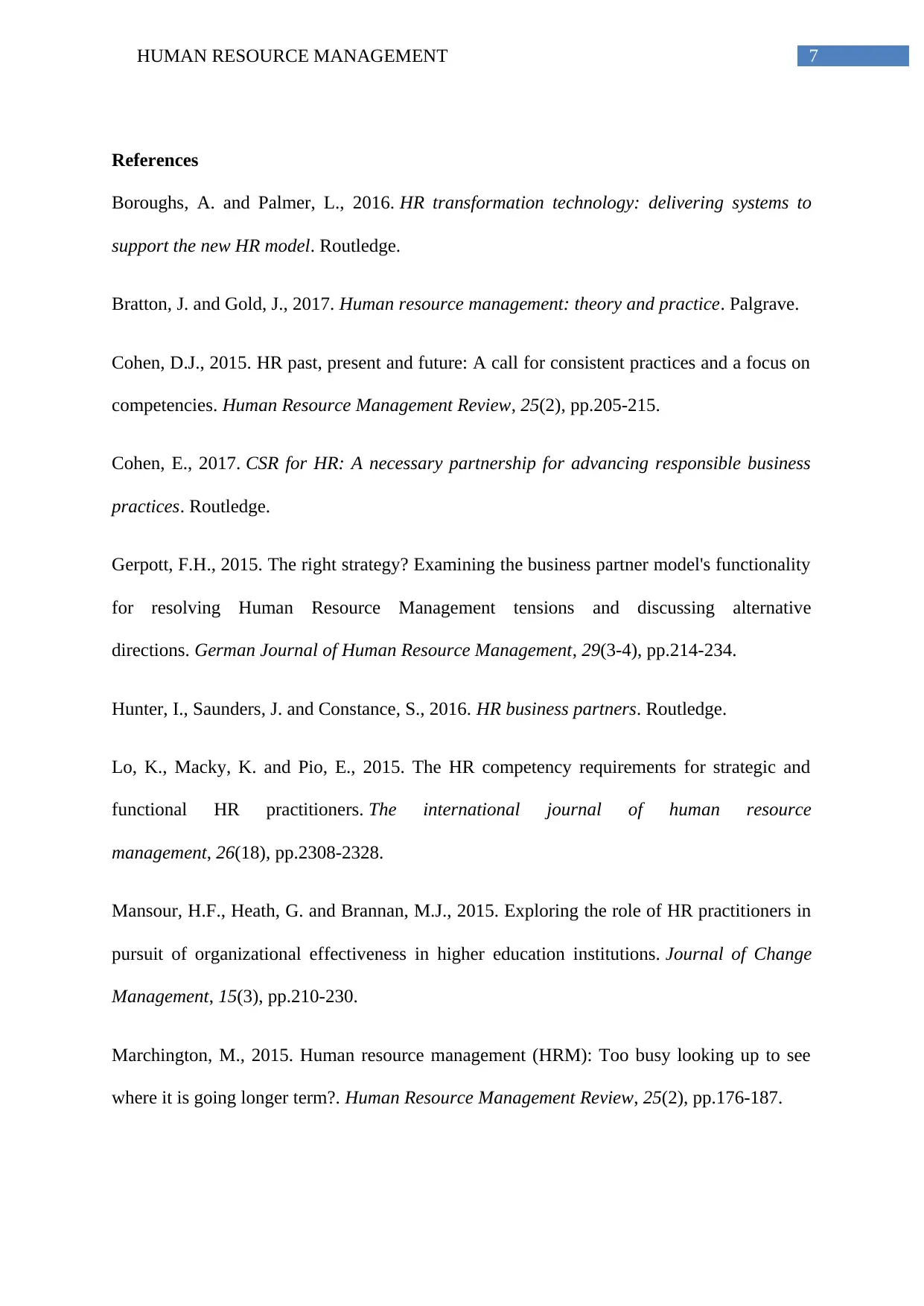
7HUMAN RESOURCE MANAGEMENT
References
Boroughs, A. and Palmer, L., 2016. HR transformation technology: delivering systems to
support the new HR model. Routledge.
Bratton, J. and Gold, J., 2017. Human resource management: theory and practice. Palgrave.
Cohen, D.J., 2015. HR past, present and future: A call for consistent practices and a focus on
competencies. Human Resource Management Review, 25(2), pp.205-215.
Cohen, E., 2017. CSR for HR: A necessary partnership for advancing responsible business
practices. Routledge.
Gerpott, F.H., 2015. The right strategy? Examining the business partner model's functionality
for resolving Human Resource Management tensions and discussing alternative
directions. German Journal of Human Resource Management, 29(3-4), pp.214-234.
Hunter, I., Saunders, J. and Constance, S., 2016. HR business partners. Routledge.
Lo, K., Macky, K. and Pio, E., 2015. The HR competency requirements for strategic and
functional HR practitioners. The international journal of human resource
management, 26(18), pp.2308-2328.
Mansour, H.F., Heath, G. and Brannan, M.J., 2015. Exploring the role of HR practitioners in
pursuit of organizational effectiveness in higher education institutions. Journal of Change
Management, 15(3), pp.210-230.
Marchington, M., 2015. Human resource management (HRM): Too busy looking up to see
where it is going longer term?. Human Resource Management Review, 25(2), pp.176-187.
References
Boroughs, A. and Palmer, L., 2016. HR transformation technology: delivering systems to
support the new HR model. Routledge.
Bratton, J. and Gold, J., 2017. Human resource management: theory and practice. Palgrave.
Cohen, D.J., 2015. HR past, present and future: A call for consistent practices and a focus on
competencies. Human Resource Management Review, 25(2), pp.205-215.
Cohen, E., 2017. CSR for HR: A necessary partnership for advancing responsible business
practices. Routledge.
Gerpott, F.H., 2015. The right strategy? Examining the business partner model's functionality
for resolving Human Resource Management tensions and discussing alternative
directions. German Journal of Human Resource Management, 29(3-4), pp.214-234.
Hunter, I., Saunders, J. and Constance, S., 2016. HR business partners. Routledge.
Lo, K., Macky, K. and Pio, E., 2015. The HR competency requirements for strategic and
functional HR practitioners. The international journal of human resource
management, 26(18), pp.2308-2328.
Mansour, H.F., Heath, G. and Brannan, M.J., 2015. Exploring the role of HR practitioners in
pursuit of organizational effectiveness in higher education institutions. Journal of Change
Management, 15(3), pp.210-230.
Marchington, M., 2015. Human resource management (HRM): Too busy looking up to see
where it is going longer term?. Human Resource Management Review, 25(2), pp.176-187.
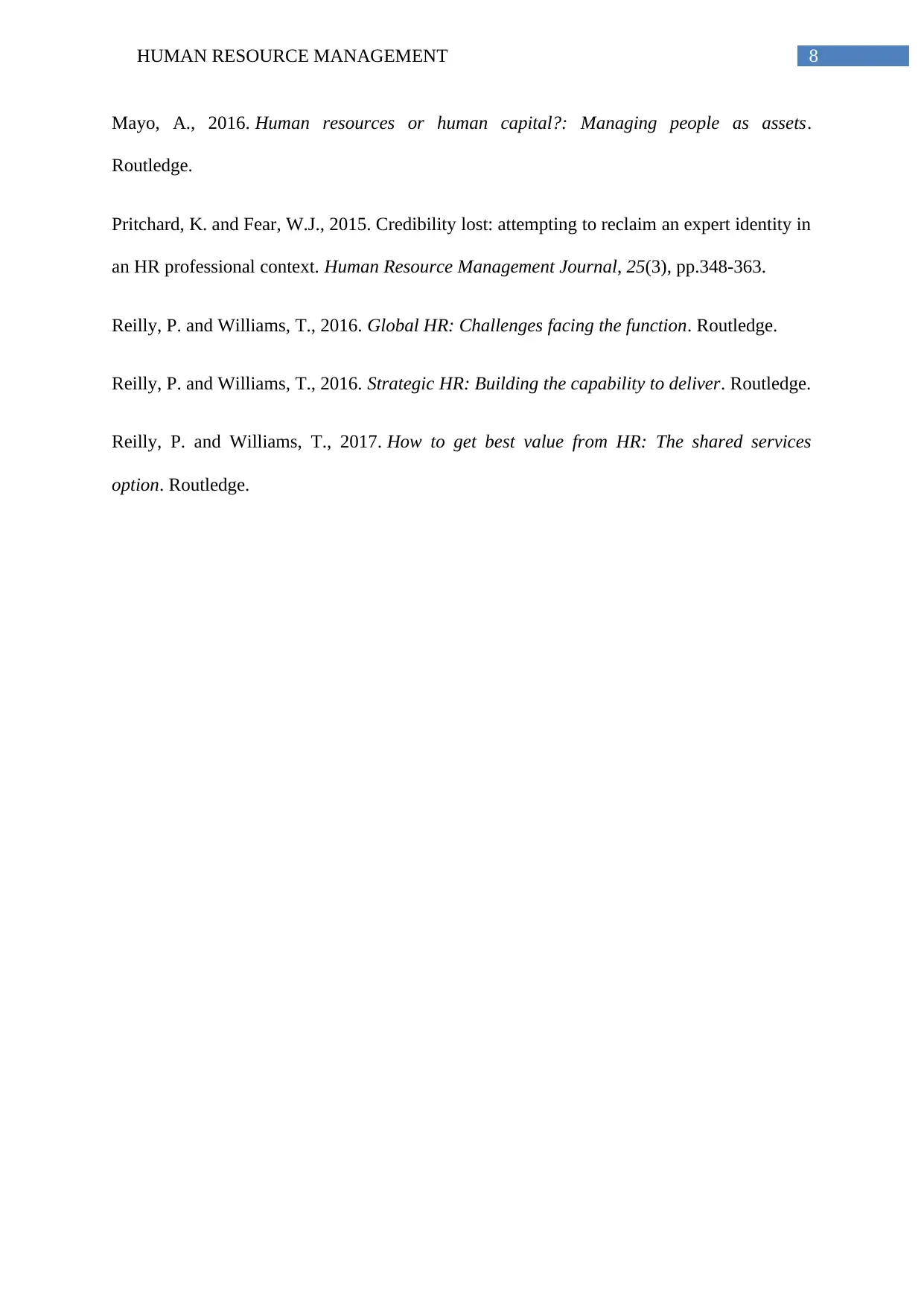
8HUMAN RESOURCE MANAGEMENT
Mayo, A., 2016. Human resources or human capital?: Managing people as assets.
Routledge.
Pritchard, K. and Fear, W.J., 2015. Credibility lost: attempting to reclaim an expert identity in
an HR professional context. Human Resource Management Journal, 25(3), pp.348-363.
Reilly, P. and Williams, T., 2016. Global HR: Challenges facing the function. Routledge.
Reilly, P. and Williams, T., 2016. Strategic HR: Building the capability to deliver. Routledge.
Reilly, P. and Williams, T., 2017. How to get best value from HR: The shared services
option. Routledge.
Mayo, A., 2016. Human resources or human capital?: Managing people as assets.
Routledge.
Pritchard, K. and Fear, W.J., 2015. Credibility lost: attempting to reclaim an expert identity in
an HR professional context. Human Resource Management Journal, 25(3), pp.348-363.
Reilly, P. and Williams, T., 2016. Global HR: Challenges facing the function. Routledge.
Reilly, P. and Williams, T., 2016. Strategic HR: Building the capability to deliver. Routledge.
Reilly, P. and Williams, T., 2017. How to get best value from HR: The shared services
option. Routledge.
1 out of 9
Related Documents
Your All-in-One AI-Powered Toolkit for Academic Success.
+13062052269
info@desklib.com
Available 24*7 on WhatsApp / Email
![[object Object]](/_next/static/media/star-bottom.7253800d.svg)
Unlock your academic potential
© 2024 | Zucol Services PVT LTD | All rights reserved.





